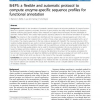Free Online Productivity Tools
i2Speak
i2Symbol
i2OCR
iTex2Img
iWeb2Print
iWeb2Shot
i2Type
iPdf2Split
iPdf2Merge
i2Bopomofo
i2Arabic
i2Style
i2Image
i2PDF
iLatex2Rtf
Sci2ools
BMCBI
2010
2010
BrEPS: a flexible and automatic protocol to compute enzyme-specific sequence profiles for functional annotation
Background: Models for the simulation of metabolic networks require the accurate prediction of enzyme function. Based on a genomic sequence, enzymatic functions of gene products are today mainly predicted by sequence database searching and operon analysis. Other methods can support these techniques: We have developed an automatic method "BrEPS" that creates highly specific sequence patterns for the functional annotation of enzymes. Results: The enzymes in the UniprotKB are identified and their sequences compared against each other with BLAST. The enzymes are then clustered into a number of trees, where each tree node is associated with a set of EC-numbers. The enzyme sequences in the tree nodes are aligned with ClustalW. The conserved columns of the resulting multiple alignments are used to construct sequence patterns. In the last step, we verify the quality of the patterns by computing their specificity. Patterns with low specificity are omitted and recomputed further down ...
| Added | 28 Feb 2011 |
| Updated | 28 Feb 2011 |
| Type | Journal |
| Year | 2010 |
| Where | BMCBI |
| Authors | Constantin Bannert, A. Welfle, C. aus dem Spring, Dietmar Schomburg |
Comments (0)

